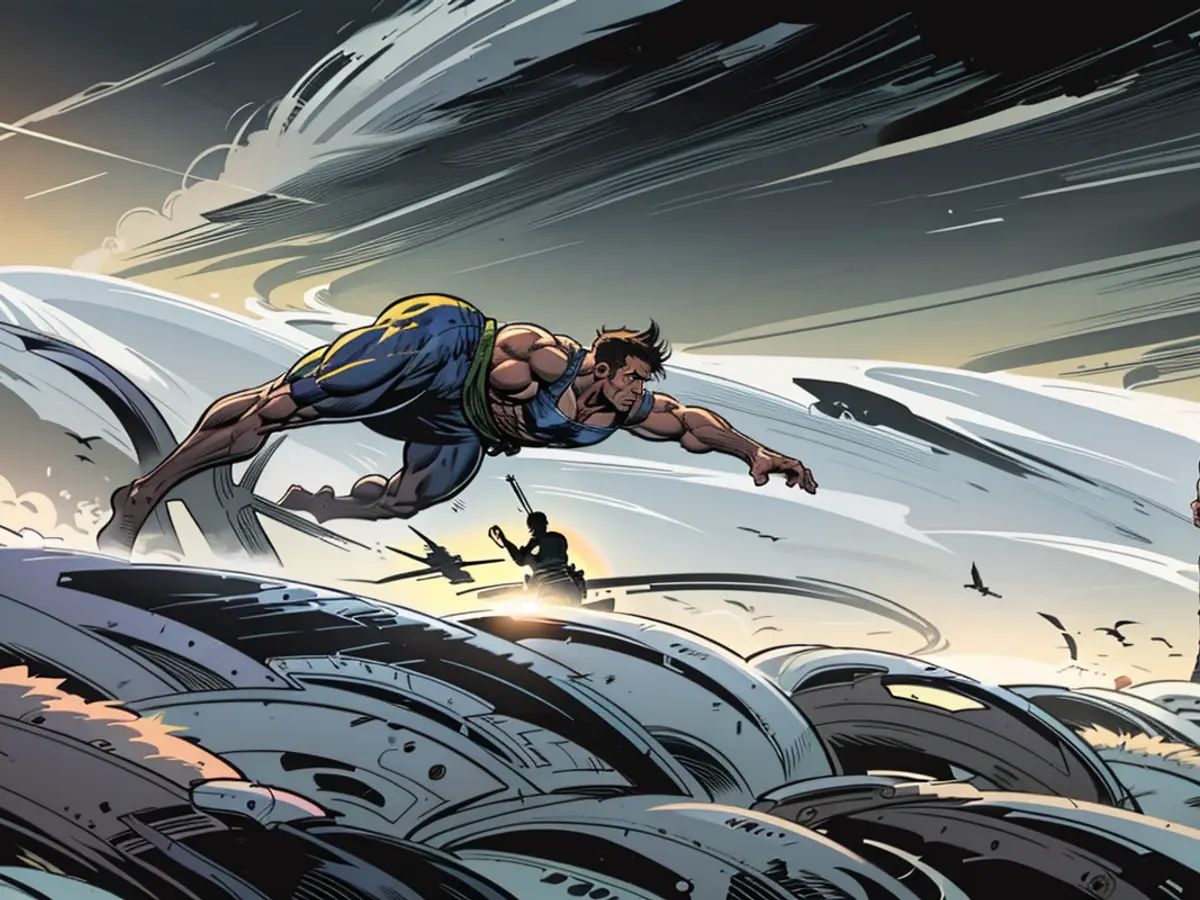War in Ukraine - Balance of the war - what is Putin achieving and where are his limits?
Ukraine Defends Itself Bravely, but the Country Stands with Its Back to the Wall. How Does It Look in the Key Areas for the War?
Sea War – Surprising Successes of Ukraine
At sea, Ukraine has achieved great successes but does not have the upper hand. Ukrainian destroyers and frigates were destroyed by the Russians at the beginning of the war. Psychologically, this has the advantage that Kiev cannot lose any more warships. The Russians cannot utilize their superiority at sea. Their large ships are valuable targets and are regularly attacked by rockets and swim drones. The Russian fleet suffers regular losses. Their counterattacks against the small drones, bases, and operators do not outweigh the loss of combat ships. The Russians are left with little else but to hide their ships at the other end of the Black Sea.
Strategic Aerial Offensive by Both Parties
Both sides attack strategic targets and infrastructure of the enemy in the depth of their territory. For Ukraine, this is a success because it was not expected of them and they are carrying the war onto Russian territory. This is done using drones that operate on simple light aircraft. They have a tremendous range and are difficult to detect and intercept in low altitude. The sheer size of the country is a problem, and the Russian defense cannot protect all imaginable targets adequately. Real influence on the course of the war has been achieved despite spectacular successes. Only the strikes on the oil refineries have a noticeable effect.
From the other side, the Russian strategic aerial offensive is ongoing. The Russians are able to attack any target in Ukraine. However, they cannot protect all zones with their drones. They have not been able to destroy the Ukrainian air force, cut off the power in the country, or interrupt the supply of the front in nearly two and a half years of war. But they are working on it, and Ukraine must accept losses every day. The attacks on the energy supply have reached a new quality in 2024. They are carefully planned and aim to completely destroy the central facilities of the installations, making repair impossible.
While Russian weapons are becoming deadlier and more precise, Ukrainian air defense outside of Kiev is getting weaker. In some regions, it does not exist. The Russians are shutting down more installations than the West is supplying new ones. A significant bottleneck is the number of defense missiles. The Russians launch more attack weapons than defense missiles are produced.
Ground War – Kiev's Front is Giving Way
The Russians have been shifting the front in their favor for months in the entire front in Donbass, pressing the Ukrainian positions. They manage to make real inroads occasionally, but their depth is limited. It remains a positional war, there is no real moving battle with space-grabbing maneuvers. Given the nature of the war in Ukraine, this is foreseeable.
Russians have enough troops to be active in other areas as well. They are tying down the Ukrainians, but the Russians also suffer from manpower shortages. Despite the vastness of the country, their superiority in troops is limited. The opening of a new front north of Kharkiv has only led to insignificant territorial gains there. However, since Kiev had to move troops to the north, it is much harder for the Ukrainians to stabilize the front in the east.
Occasionally, it is argued that the Russian advance is so slow that they will still need over ten years to reach the Dnepr. This is not entirely incorrect, but it overlooks the nature of the fighting. Kiev cannot sustain this prolonged resistance for another ten years. Russia's calculations are based on the fact that continuous losses will eventually lead to the collapse of larger units and front sectors.
Arms Production and Finances – Dependence on the West
Moscow has surprised the world in this regard. The West assumed that its "unprecedented" sanctions would force Russia into submission, that both the financial system and the arms industry would collapse. Production of precision weapons was expected to end within a few months. None of that happened. Putin finances the war with revenues from raw materials, and the Russian arms industry is stronger than ever.
Kiev, on the other hand, is almost entirely dependent on aid from supporter states. It cannot wage the war or finance the state budget on its own. This is an extreme imbalance, as the supporter states, not Kiev, determine the size of the aid.
As long as it lasts, this may be acceptable. However, if major supporters – like the USA under a potential President Trump – were to withdraw, the system would collapse. Russia has entered a war economy and is preparing a mental mobilization of the entire country. This is something that cannot be discussed in the supporter states of Ukraine. France, Germany, and the UK remain peace-loving societies where citizens are more concerned with vacations than the war in the east. Our societies mobilize only a fraction of their theoretical capacity for the cause of Ukraine.
Losses – the Big Secret
The essential narrative that supports a chance of victory for Kiev is based on losses. In essence, it states that Russian losses are significantly higher than Ukrainian losses. For Ukraine to have a chance, Russia must suffer multiple times the Ukrainian losses. A few percentages are not enough. This narrative is based on misleading propaganda terms such as "meat grinder attacks" or "human wave attacks." Something more objective, that the attack in general results in more losses than defense. Visually, it is illustrated with videos showing Russian attacks crumbling in the Ukrainian fire.
Against this assumption, the indisputable superiority of the Russians in terms of firepower speaks out. They are far superior to the Ukrainians in light artillery such as 120-mm Mortars and heavier, 152-mm Howitzers. In some cases, they were ten times as many, and with new ammunition supplies, it is now "only" five to one. In addition, they possess destruction weapons that Ukraine does not have. For instance, the thermobaric TOS-Rocket Launchers. But most notably, Russian glide bombs should be mentioned. They range from 250 kilograms to bombs of 3000 kilograms. Each of these bombs results in losses – a 3-tonne bomb destroys a fortified factory building along with its crew with a single strike. Currently, the Russians are estimated to be using approximately 3000 glide bombs per month.
Strategic Goals
At first glance, it appears to be a clear success for Ukraine: Putin aimed to crush Ukraine's independent, pro-Western government within a few days and replace it with a Moscow-friendly regime. Almost two and a half years later, free Ukraine still exists. However, if we look deeper, the picture becomes less clear.
The NATO has grown further with Sweden and Finland. Putin now has another border with a NATO state, and the Baltic Sea has become a NATO inland sea.
But Putin can also claim victories. The first and perhaps decisive one: The Global South has made the West hesitant with its desire to join the economic war and the sanctions regime. And by making it clear that they would follow an independent course in the future. Western diplomats have greatly overestimated their global influence and were rudely awakened in 2022.
Moreover, the Moscow-Beijing axis has grown much closer strategically. In a potential confrontation with China, Russia will stand firmly by China's side. Furthermore, the declared enemies of the West (Russia, Iran, North Korea, and with restrictions China) have formed a military cooperation alliance. To top it off, France has lost its postcolonial grip on the countries of North Africa in this period. China and Russia are now filling that void.
Outlook – no "carry on as is!"
Since no one knows the exact situation at the front, any outlook is speculative. In short, Kiev has little time left. No matter how heroic the defensive fight may be, it cannot last forever. The situation in the Donbass is not static and orderly. The creeping offensive of the Russians is successful, and it is gaining momentum. The disintegration of the front is increasing.
Western experts hope that Russian weapons production will significantly decline by 2026. However, Kiev cannot sustain the war until 2026. A "Hang in there and carry on as is!" will not suffice. Kiev will not launch a major offensive in 2024, but the conditions for the defensive fight must be significantly improved immediately.
Ukraine needs much more air defense. The largest part of the country is currently an "unroofed house." The Russians can strike whenever they choose a target. Defense alone will not be enough. The Ukrainian Air Force must quickly bring Western jets like the F-16 or Mirage into the air to stop Russian glide bombs. The ground troops cannot withstand 3000 glide bombs per month for two years.
At the same time, sufficient war material must come into the country to restock new units and compensate for losses at the front. If this does not happen, the situation will significantly worsen before Donald Trump possibly moves back into the White House.
- The Ukrainian defense strategy relies heavily on its navy, especially in the Donets Basin, where drones and swim drones are used to counteract the Russian fleet's superiority at sea.
- Donald Trump, as a potential future president, could have a significant impact on Ukraine's war efforts, as the country is heavily dependent on aid from its supporters.
- The strategic aerial offensive by Russia in Ukraine has been ongoing, but their attacks on energy supply installations have reached a new level in 2024, aiming to completely destroy central facilities and make repairs impossible.
- Paris, Berlin, and London are primarily concerned with vacations rather than the war in Ukraine, despite the country's dependence on their aid.
- The Russian defense industry has been strengthened by Moscow's focus on raw materials revenue and local production, even as international sanctions aimed to limit its capacities.
- The Russian Army has been suffering regular losses due to attacks by small drones and swim drones, which Moscow has found difficult to counter effectively despite their superiority in numbers and firepower.









